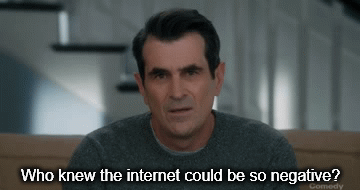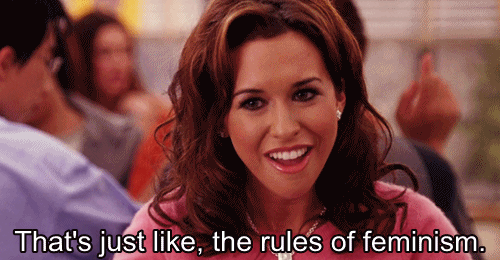“Portions of this site and the works within it are being produced with the intention of critique and/or educational use under Australia's 'fair dealing' exceptions to copyright (Section 40 & 41). However, if you feel your IP is being infringed, please contact my service provider (tumblr) with the appropriate DMCA requests, as I, the single author take full responsibility for the content of this site.”
Don't wanna be here? Send us removal request.
Text
Digital Citizenship; The Cause of Social Media Conflict...

Social media governance is how the internet is run, and the regulations that are implemented online. The government regulates society and provides punishments for any individual that resists the laws, however, is there the same regulations online in terms of harassment and harm?
The conflict on social media is often caused from Digital Citizenship. Digital Citizenship is a term coined to “reflect the ethical, safe, and responsible use of internet technologies” (Lauricella, A. R., 2020), however with the growth of social media, and the agency that users have to express their opinions freely, the digital environment is not always free from harm. Through the growth of social media, comes numerous downfalls, for instance cyber-bullying, which often leads to mental health issues, and even possibly suicide. These digital conflicts, abuse and harassment have generated laws and “platform controls”, to enhance the safety of users online (McCosker, A., 2016). Cyber-safety is related to Digital Citizenship, as individuals are able to “participate” with social media and online content, however, are expected to abide to “norms and assumptions” in regard to how to properly treat others (McCosker, A., 2016).

Additionally, unlike the laws and expectations that people have to abide by in everyday life, social media does not have any particular set of rules, it is simply expected for individuals to self-regulate what they post online. However, due to the anonymity of social media accounts, many people choose to bully and harass others online for their own “amusement” (Dahlberg, 2001 (as referenced in Week 10 Lecture Powerpoint)), which unfortunately cannot always be censored and sanctioned. Overall, Digital Citizenship focuses on the “role and responsibilities” that users have on social media, (Lauricella, A. R., 2020) which can ultimately create both a positive and negative space.
References
Lauricella, A. R., Herdzina, J., & Robb, M. (2020). Early childhood educators’ teaching of digital citizenship competencies. Computers and Education, 158, 103989–. https://doi.org/10.1016/j.compedu.2020.103989
McCosker; Vivienne; Johns Negotiating digital citizenship : control, contest and culture Littlefield: 2016
Pangrazio, L., & Sefton-Green, J. (2021). Digital Rights, Digital Citizenship and Digital Literacy: What’s the Difference? Journal of New Approaches in Educational Research, 10(1), 15–27. https://doi.org/10.7821/naer.2021.1.616
0 notes
Text
Gaming Communities; What Good Do They Offer?

With the rise of the Internet and social media, individuals from all across the world are coming together to share their passion for online gaming. As of 2023, there are over 5.16 billion internet users worldwide (Statista, 2023), and approximately 3.9 billion video gamers (Exploding Topics, 2023). Through social media, came the creation of gaming streaming platforms, such as Discord and Twitch (Bergstrom et. al, 2022), or even early “social cam websites” such as Justin.tv and Ustream (Taylor T.L., 2018), which created a community among gamers, both viewers and players. During the recent COVID-19 pandemic saw millions of people cooped up in their homes, unable to engage in “normal activities”, therefore creating an “increased consumption of digital entertainment”, in particular video game streaming, playing and communicating (King, D., et al., 2020). During quarantine, live-streaming platforms, such as Twitch and YouTube Gaming, had an increase of 10% in its audience viewing (King, D., et al., 2020), which implies that people were seeking an alternative form of communication than the face-to-face they were once used to and took for granted.

The most common explanation for the increasement of digital consumption is due to “having extended free time to use the Internet and engage in gaming due to the stay-home measure” (Higuchi, S., et al., 2020), which further establishes the argument of how through boredom, can create a likeminded community. Game live streaming occupies multiple benefits, one of which being its progressiveness. Broadcasting this particular content “weave[s] together all these threads”, combining “televisual, computer games, the internet, and computer-mediated communication” (Taylor T.L., 2018), which ultimately establishes a community, with people both globally and locally, to come together and share a passion for gaming. However, through the rise of this phenomenon, it may negatively affect gaming behaviour from those with addictive natures. Particularly throughout COVID-19 lockdowns, some individuals may “develop, increase or relapse into unhealthy [gaming] patterns” (King, D., et al., 2020). However, these live streams and gaming communities also provide individuals, particularly those of a shy nature, to get out of their comfort zones, and gain confidence to be able to socially interact.
References
Bergstrom, K., & Poor, N. (2022). Signaling the Intent to Change Online Communities: A Case From a Reddit Gaming Community. Social Media + Society, 8(2), 205630512210968–. https://doi.org/10.1177/20563051221096817
Chia, A., Keogh, B., Leorke, D., & Nicoll, B. (2020). Platformisation in game development. Internet Policy Review, 9(4). https://doi.org/10.14763/2020.4.1515
Higuchi, S., Mihara, S., Kitayuguchi, T., Miyakoshi, H., Ooi, M., Maezono, M., Nishimura, K., & Matsuzaki, T. (2020). Prolonged use of Internet and gaming among treatment seekers arising out of social restrictions related to COVID‐19 pandemic. Psychiatry and Clinical Neurosciences, 74(11), 607–608. https://doi.org/10.1111/pcn.13127
Howarth, J. (2023, January 18). How many gamers are there? (New 2023 statistics). Exploding Topics. https://explodingtopics.com/blog/number-of-gamers
King, D. L., Delfabbro, P. H., Billieux, J., & Potenza, M. N. (2020). Problematic online gaming and the COVID-19 pandemic. Journal of Behavioral Addictions, 9(2), 184–186. https://doi.org/10.1556/2006.2020.00016
Petrosyan, A., & 3, A. (2023, April 3). Internet and social media users in the world 2023. Statista. https://www.statista.com/statistics/617136/digital-population-worldwide/
Taylor, TL 2018, ‘Broadcasting ourselves’ (chapter 1), in Watch Me Play: Twitch and the Rise of Game Live Streaming, Princeton University Press, pp.1-23
0 notes
Text
Instagram and Snapchat Filters; Entertaining and Humorous ... But For Who?

A common trend seen on social media is the desire and expectation to look ‘perfect’. The “battlefield” that women on social media continuously face is through the particular “image” (Coy-Dibley, I., 2016) that society expects them to uphold, such as flawless skin and a narrow nose (Barker, J., 2020). 57% of young people believe their mental health is getting worse as a result of social media (Headspace, 2022), and this draws a connection to the unrealistic beauty standards that are advertised on social media platforms.
In particular, in 2015, Snapchat invented ‘Lenses’, or “face filters”: an “augmented reality technology”, that alters the facial shape, and features of the user’s face (Barker, J., 2020). Augmented Reality simply is an “interface…that seamlessly blends interactive digital content into a person’s view of the physical environment” (Chylinski, M., et al, 2020), in this instance, Snapchat and Instagram Filters, in which a user can alter their appearance in both comedic and in superficial ways.

These filters create a distortion of a person’s self-image (Barker, J., 2020), which can be seen as a downfall for society. For generations, women have been expected to act, look and speak a certain way, and it appears that through these ‘filters’, women are still subject to these societal “standard” images of how they should perceive themselves (Coy-Dibley, I., 2016). Originally, women were comparing themselves to who they saw on the television and in magazines, however now, with the simple unlocking of their phones, without even the need to look at another woman’s picture, they are witness to these sculpted, unattainable and unrealistic “types of feminine aesthetics” (Coy-Dibley, I., 2016).
Although Snapchat and Instagram’s “digital adornment” features (Barker, J., 2020), can be seen as humorous and entertaining, they present an underlining systematic issue that women have to consistently face, due to society’s expectations and values.
References
Barker, Jessica. (2020). 'Making-up on mobile: The pretty filters and ugly implications of Snapchat'. Fashion, Style & Popular Culture. 7. 207-221. 10.1386/fspc_00015_1.
Chylinski, M., Heller, J., Hilken, T., Keeling, D. I., Mahr, D., & de Ruyter, K. (2020). Augmented reality marketing: A technology-enabled approach to situated customer experience. Australasian Marketing Journal, 28(4), 374–384. https://doi.org/10.1016/j.ausmj.2020.04.004
Coy-Dibley, I. (July, 2016). “Digitised Dysmorphia” of the Female Body: The Re/Disfigurement of the Image 2:16040 doi: 10.1057/palcomms.2016.40
Headspace, (May 9, 2022), Young people cite social media as main reason for worsening mental health,
Miller, LA & McIntyre, J 2022, ‘From surgery to Cyborgs: a thematic analysis of popular media commentary on Instagram filters’, Feminist media studies, vol. ahead-of-print, no. ahead-of-print, Routledge, pp. 1–17.
Rettberg J.W. (2014) 'Filtered Reality'. In: Seeing Ourselves Through Technology: How We Use Selfies, Blogs and Wearable Devices to See and Shape Ourselves. Palgrave Macmillan, London.
0 notes
Text
Social Media Body Modifications; The Good, The Bad and The Ugly Side of the Internet

Social media is one of the biggest elements in a contemporary human’s way of life. In 2021, over 4.26 billion people were using social media (Dixon, S., 2023), and no doubt that figure has raised since. Individuals turn to social media for multiple reasons; communication, entertainment, education, etc, which can be established as both positive and negative. Unsurprisingly, with the rise of social media comes social media influencers. These individuals are both “desired” and “loathed” by the public, described as people who are “out of touch” with reality (McCorquodale, S., 2019). However, these influencers can be incredibly respected, as some can get paid up to $31,000 AUD for a single travel post (Kay, S., et al, 2020), meaning they know their own self-worth and what their content is worth.

Through these social media influencers comes the concept of ‘perfectionism’. Constantly being surrounded by these social media influencers, can create a negative space for users, who focus on how they can “measure up” with others on the Internet (Messinger, H., 2019). Influential figures on social media, such as the Kardashian/Jenner family, share the desire to be and look perfect, and this is consistently achieved through plastic surgery and other cosmetic procedures. Referred in Dorfman, R. G.,’s (et al) studies, the American Academy of Facial Plastic and Reconstructive Surgery’s 2017 statistics demonstrated that 42% of surgeons have reported that their patients have requested cosmetic procedures and surgeries to “improve their appearance” on social media (Dorfman, R. G., et al, 2018), which can create an unrealistic standard for their followers on the internet.
On the contrary, social media is not solely a space for negativity. Paediatric burn physiatrist, Dr Carolina Camilo, in Santiago, Dominican Republic, reveals that through her access to social media, in particular Facebook educational groups, she was given the opportunity to properly assist her burn patients. Before the help of social media, Dr Camilo wasn’t qualified enough to “prevent her young patients from scarring”, however through social media, she is now able to “build her skills” (Thompson, S., 2016).
The medical world is constantly improving, and through social media, and with the help of social media influencers, this can be both a positive and negative experience. However, it is important to acknowledge who is reputable in giving advice and providing education, and who is doing it simply for a buck.
References
Dixon, S., Feb 13, 2023
Kay, S., Mulcahy, R., & Parkinson, J. (2020). When less is more: the impact of macro and micro social media influencers’ disclosure. Journal of Marketing Management, 36(3-4), 248–278. https://doi.org/10.1080/0267257X.2020.1718740
McCorquodale, S. (2019). Influence : how social media influencers are shaping our digital future. Bloomsbury Business.
Messinger, H., Nov 19. 2019, Dis-like: How Social Media Feeds into Perfectionism https://www.pennmedicine.org/news/news-blog/2019/november/dis-like-how-social-media-feeds-into-perfectionism
Robert G Dorfman, Elbert E Vaca, Eitezaz Mahmood, Neil A Fine and Clark F Schierle, ‘Plastic Surgery-Related Hashtag Utilization on Instagram: Implications for Education and Marketing’, Aesthetic Surgery Journal, Volume 38, Issue 3, March 2018, pp 332–338
Thompson, S., March 15, 2016, How Social Media Is Transforming Medical Care In The Developing World, https://www.fastcompany.com/3057869/how-social-media-is-transforming-medical-care-in-the-developing-world
0 notes
Text
Slow Fashion; The Saviour of the Environment, but the Destroyer of Bank Accounts

‘Slow fashion’ is quite simply the “opposite of fast fashion” (Chi, T., et. al, 2021). Fashion consumers, predominately females, have recently “[paid] attention to” (Domingos, M., et. al, 2022) the “fast and ever-changing trend cycles” (Chi, T., et. al, 2021), and the impacts that ‘fast fashion’ has on the environment.
With recent conversations concerning global warming and the state of the planet, many consumers are implementing a more sustainable fashion taste, by utilising core behaviours: “ethical values”, “sustainable consumption”, “consumer motivations”, “consumer attitudes”, and “sustainability awareness” (Domingos, M., et. al, 2022). These core behaviours underline “ethical consumerism”, which is where consumers acknowledge the effects of ‘fast fashion’, through overconsumption and waste, which influences a demand for clothing to be created in non-harmful ways, to both the environment and workers (Pookulangara, S., & Shepherd, A., 2013).
Leading fashion brands, such as Zara, change their “in-store collection” more frequently than necessary, which raises concerns about their “business philosophy” and “core values” (Domingos, M., et. al, 2022) i.e., does this brand have any awareness about its effects on the environment, or do they only have concerns for their popularity and income?

However, there are some concerns regarding ‘slow fashion’, its convenience. Slow fashion’s higher price point is segregating consumers, as the individuals that fit into the lower-class category, can only afford clothing at the price that fast fashion pieces usually retail for, compared to individuals in a higher-working class, who can easily afford a “longer product life cycle” piece or a collection of pieces (Chi, T., et. al, 2021).
Slow fashion is ever-growing. The major shifts in the ways that popular fashion brands, such as Zara and H&M, produce and distribute their clothing, may assist in growing out of the overconsumption of ‘trendy’ clothing, and unsustainable ways of producing clothing.
References
Domingos, Mariana, Vera Teixeira Vale, and Silvia Faria. (2022). "Slow Fashion Consumer Behavior: A Literature Review", Sustainability 14, no. 5: 2860. https://doi.org/10.3390/su14052860
Pookulangara, S., & Shephard, A. (2013). Slow fashion movement: Understanding consumer perceptions—An exploratory study. Journal of Retailing and Consumer Services, 20(2), 200–206. https://doi.org/10.1016/j.jretconser.2012.12.002
Ting Chi, Jenisha Gerard, Yuhfen Yu & Yuanting Wang (2021) 'A study of U.S. consumers’ intention to purchase slow fashion apparel: understanding the key determinants' , International Journal of Fashion Design, Technology and Education, 14:1, 101-112, DOI: 10.1080/17543266.2021.1872714
0 notes
Text
Digital Citizenship; Positive or Negative? Or Both?

Digital Citizenship explores the ways people interact online. Users have the freedom to participate in a conversation and share their opinions, as a form of “civic engagement” (Tapingkae et. al, 2020), which can be seen as both a positive and negative concept. However, in this particular instance, digital citizenship concerns the behaviour of users online that may create a harassing and disrespectful space (Tapingkae et. al, 2020), which, ultimately, can cause the demobilisation of people (Theocharis et. al, 2023).
Researchers argue that digital citizenship should be addressed and taught in an educational setting so that young people in the community are aware of their “rights and responsibilities” with what they put online, which should construct an understanding of the digital footprint (Choi & Cristol, 2021). Digital footprint refers to the “digital traces” (Weaver, S. D., & Gahegan, M., 2007) that people leave online; their actions, their comments, their posts, their shares etc, which ultimately leads to the idea of digital citizenship. It is crucial for all users of the Internet to be aware of their capabilities and ensure to not post, share, like or comment on any harmful or derogatory content, because it may come to affect them at a later time.

Through social media platforms, and digital citizenship, users are given the ability to utilise their agency and influence online participation. Electoral campaigns, protest events, volunteer groups and the promotion of inclusivity are formed, which creates community groups and safe spaces (Theocharis, 2023). During 2020, with the rise of the Black Lives Matter (BLM) movement, groups and individuals were able to “effectively” share and “enhance” their messages and experiences, which created an understanding of how digital citizenship marginalises and oppresses certain communities and people (Choi, M., & Cristol, D., 2021).
Through digital citizenship, users are able to understand and recognise “discipline” (Choi, M., & Cristol, D., 2021), which allows for a safe and ethical space online, which ultimately generates a unified community.
References
Moonsun Choi & Dean Cristol (2021) 'Digital citizenship with intersectionality lens: Towards participatory democracy driven digital citizenship education', Theory Into Practice, 60:4, 361-370, DOI: 10.1080/00405841.2021.1987094
Tapingkae, P., Panjaburee, P., Hwang, G.-J., & Srisawasdi, N. (2020). Effects of a formative assessment-based contextual gaming approach on students’ digital citizenship behaviours, learning motivations, and perceptions. Computers and Education, 159, 103998–. https://doi.org/10.1016/j.compedu.2020.103998
Weaver, S. D., & Gahegan, M. (2007). Constructing, Visualizing, and Analyzing A Digital Footprint. Geographical Review, 97(3), 324–350. https://doi.org/10.1111/j.1931-0846.2007.tb00509.x
Yannis Theocharis, Shelley Boulianne, Karolina Koc-Michalska & Bruce Bimber (2023) Platform affordances and political participation: how social media reshape political engagement , West European Politics, 46:4, 788-811, DOI: 10.1080/01402382.2022.2087410
#MDA20009#digital citizenship#engagement#influence#agency#users#space#negativity#positivity#safe space#blm movement
1 note
·
View note
Text
Reality TV; More Talked About Than Watched?

“Reality TV is often more talked about than watched” (Hill, A., 2015). Ultimately this can be considered accurate, as upon searching up ‘Reality TV’ on Google’s search page, just under two billion searches pop up, and although there isn’t an official list of how many reality tv shows there are, it is guaranteed there aren’t two billion. Plus, the two billion searches aren’t taking social media into account either, including Twitter, Instagram, Tumblr, Facebook etc, which is where a majority of the gossip occurs. 94% of people turn to Twitter (Twitter News, 2022) to talk about current events, and contemporary current events seem to include the latest scandal in reality TV. Daily Mail has a section on its website dedicated to ‘TV&Showbiz’, full of the latest trending news and scandals (Daily Mail, 2023), which proves how relevant and current reality TV is in the news. Through these Twitter chats, posts and replies about Reality TV and a particular show, it “privileges ‘liveness’” (Dellar, R.A., 2019), which creates a space of unity and connection between viewers of the shows.

Viewers of reality TV are a part of the ‘public sphere’, a space where communities co-exist, intersect and overlap in multiple forms across media platforms” (Bruns & Highfield), and this is an example on Twitter, where viewers follow hashtags, or on Facebook, where people create group chats about particular reality TV shows. The liveness of reality TV creates a space “[where viewers are] engaging with the same television content at the same time” (Stewart, M., 2020). As mentioned previously, this creates a unified community, who enjoy the same content, however, reality TV can also be described as “’water-cooler television’” (Stewart, M., 2020). Ultimately, this establishes Reality TV has content that the vast majority of people (in particular, colleagues, peers, family members and friends) have all seen, which creates micro-communities and groups who can all come together and share their opinions, thoughts and hashtags.
References
Bruns, Axel & Highfield, Tim (2016) Is Habermas on Twitter? Social media and the public sphere.
Daily Mail (Accessed: March 20, 2023) https://www.dailymail.co.uk/tvshowbiz/reality-tv/index.html
Deller, Ruth A, (2019) Extract: 'Chapter Six: Reality Television in an Age of Social Media' Download 'Chapter Six: Reality Television in an Age of Social Media'in Reality Television: The TV Phenomenon That Changed the World (Emerald Publishing).
Stewart, Mark (2020) ‘Live Tweeting, Reality TV and the Nation’ ‘Live Tweeting, Reality TV and the Nation’23(3) International journal of cultural studies 352.
Twitter News, (Sept 12, 2022), How many people come to Twitter for news? As it turns out, a LOT. https://blog.twitter.com/en_us/topics/insights/2022/how-many-people-come-twitter-for-news
0 notes
Text
Tumblr: A Safe Haven for Young Feminists

When you wish to anonymously relate to people globally, share your honest thoughts and opinions, and speak freely without the fear of intense judgement, sign up for Tumblr. This platform is home for passionate and anonymous users to share their interests, without needing to imitate who they are on the “outside” (McCracken, A, et.al 2020), and in this particular discussion, the matter is on young feminists.
In comparison to Facebook, the “more conservative platform” (Keller, J, 2019), Tumblr allows young women, who identify as feminists, to express their opinions and information freely, to an audience that purposely seeks to connect and associate with related topics. Research conducted on American, Canadian, and British teenage girls discovered that using Facebook, as the main form of sharing feminist posts, sparks a “risk of family dispute” (Keller, J, 2019), meaning that these teenage girls will need to cautiously and strategically choose which platform to use to spread their messages on.

Within Tumblr’s unique digital community, anonymity and inclusivity, offer young feminists to have a safe space, which ultimately allows the spread of these contemporary feministic ideals. The fact that Tumblr provides an opportunity for users to have no identity, means that they can connect with like-minded individuals and avoid the fear of their posts and opinions attaching to their digital footprint. The tracking of users’ memories, moments and behaviours (Muhammad, S. S, et.al, 2018) on social media platforms, affects the ways in which people wish to express their opinions and concerns.
Referring to the study conducted on teenage girls and their preferred choice of platform, which they primarily use to articulate their feministic interests, they utilise the choice of anonymity on Tumblr, as it provides no limitation on what they can convey their messages about.
As one of Australia’s leading social media apps, at over 2 million downloads (Hughes, 2023), Tumblr provides a “safe haven” (Reeve, E, 2016) for these young feminist women and allows their abilities to freely express opinions about sensitive topics, such as body positivity, r@*e, and primarily women’s rights.
References
Hughes, C. (2023, February 1). Most popular social media apps australia 2022. Statista. Retrieved March 13, 2023, from https://www.statista.com/statistics/1220232/australia-leading-social-media-apps-by-downloads/#:~:text=Research%20from%20AppMagic%20suggested%20that,Instagram%2C%20Pinterest%2C%20and%20Google.
Keller, J. (2019). “Oh, She’s a Tumblr Feminist”: Exploring the Platform Vernacular of Girls’ Social Media Feminisms. Social Media + Society, 5(3), 205630511986744–. https://doi.org/10.1177/2056305119867442
McCracken, A., Cho, A., Stein, L. E., & Hoch, I. N. (2020). A Tumblr book : platform and cultures (A. Cho, L. E. Stein, & I. N. Hoch, Eds.). University of Michigan Press.
Muhammad, S. S., Dey, B. L., & Weerakkody, V. (2018). Analysis of Factors that Influence Customers’ Willingness to Leave Big Data Digital Footprints on Social Media: A Systematic Review of Literature. Information Systems Frontiers, 20(3), 559–576. https://doi.org/10.1007/s10796-017-9802-y
Reeve, E. (2016). THE SECRET LIVES OF TUMBLR TEENS. The New Republic, 247(3), 46–.
1 note
·
View note